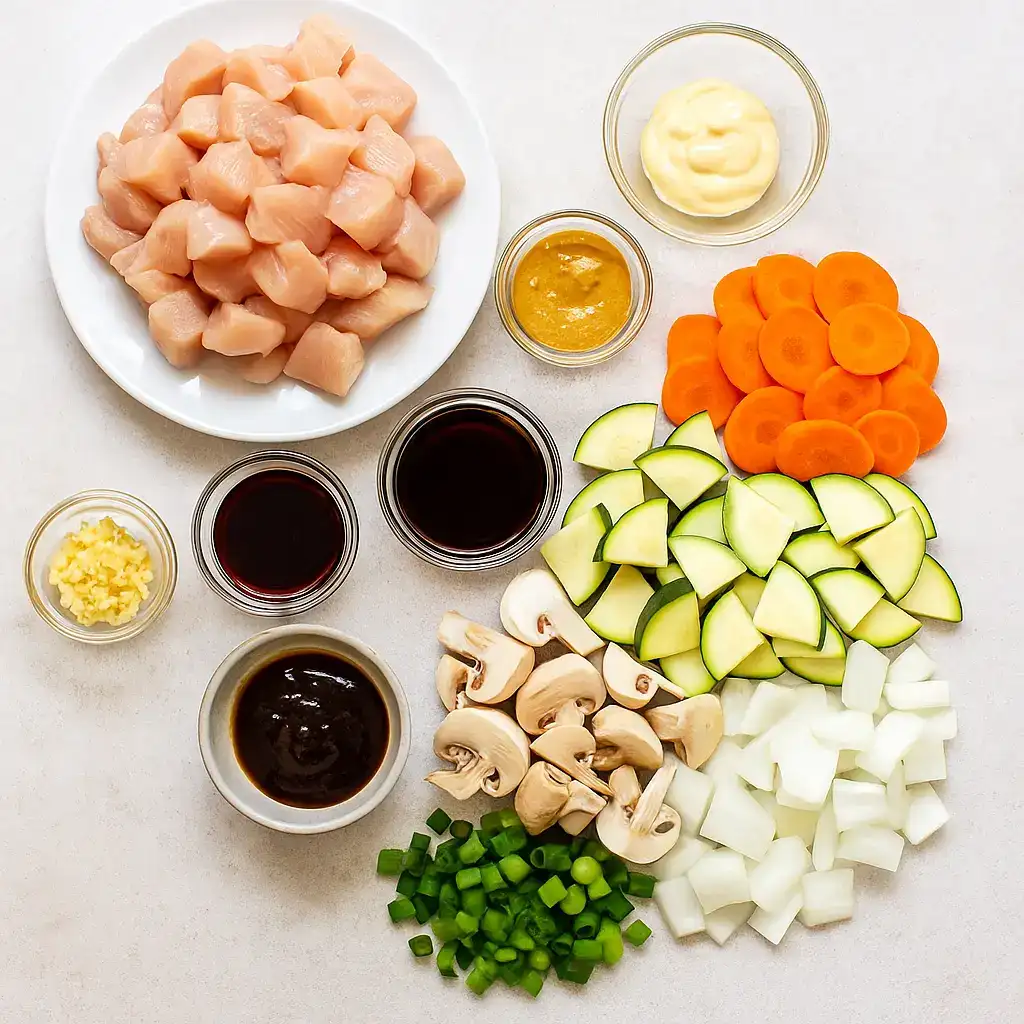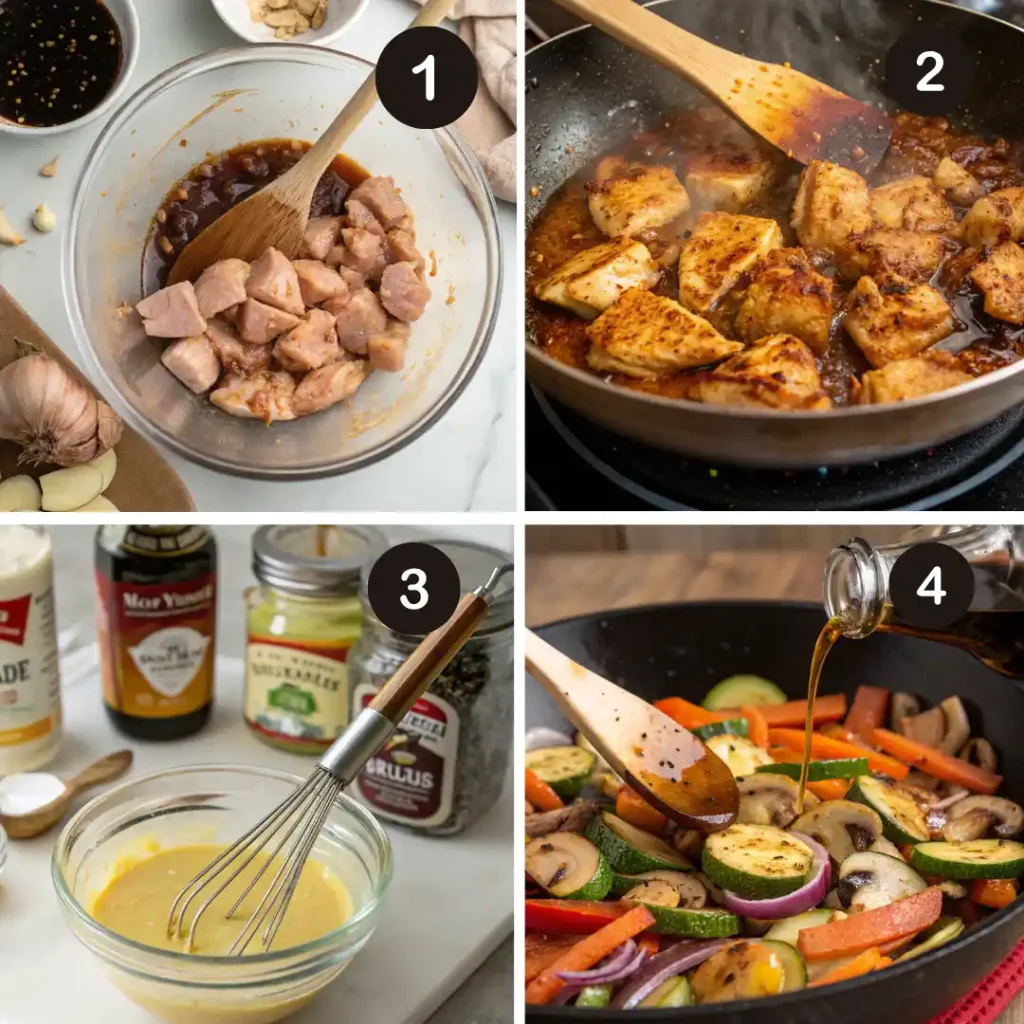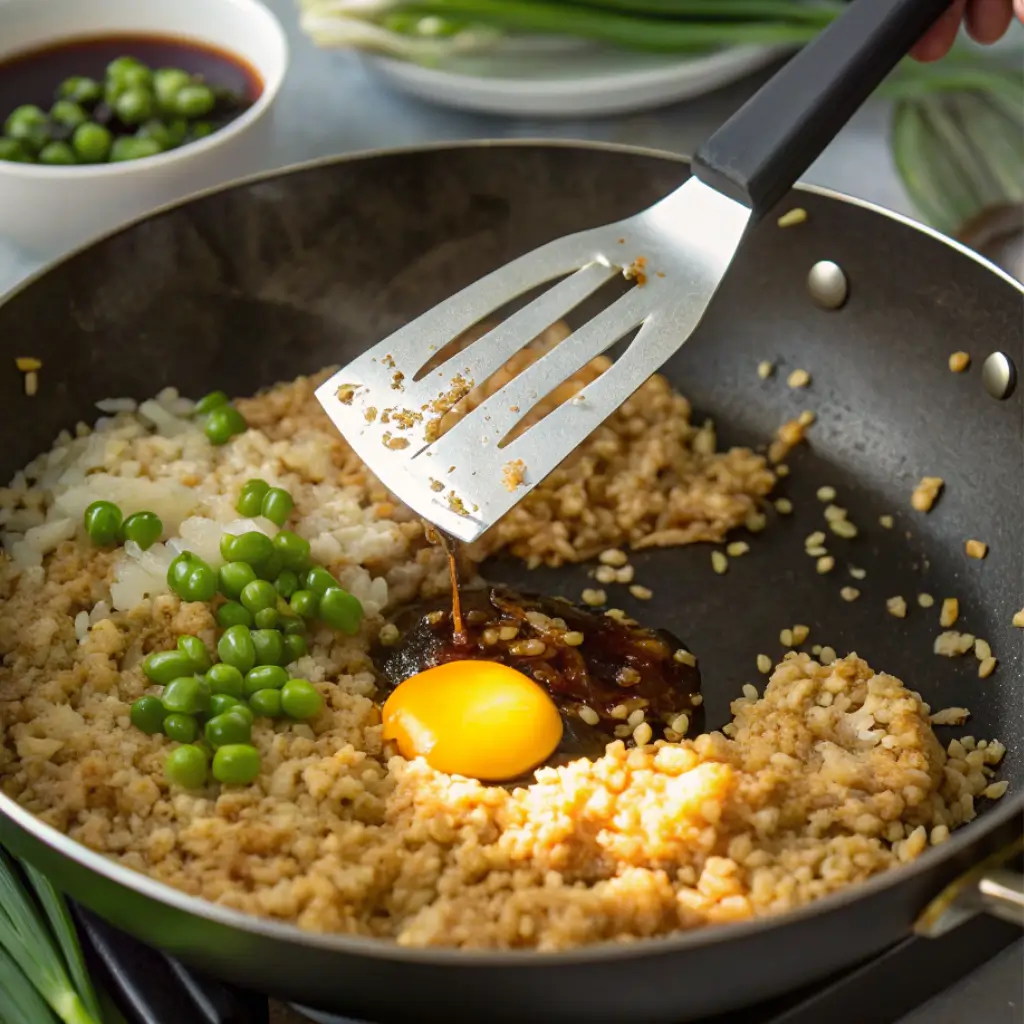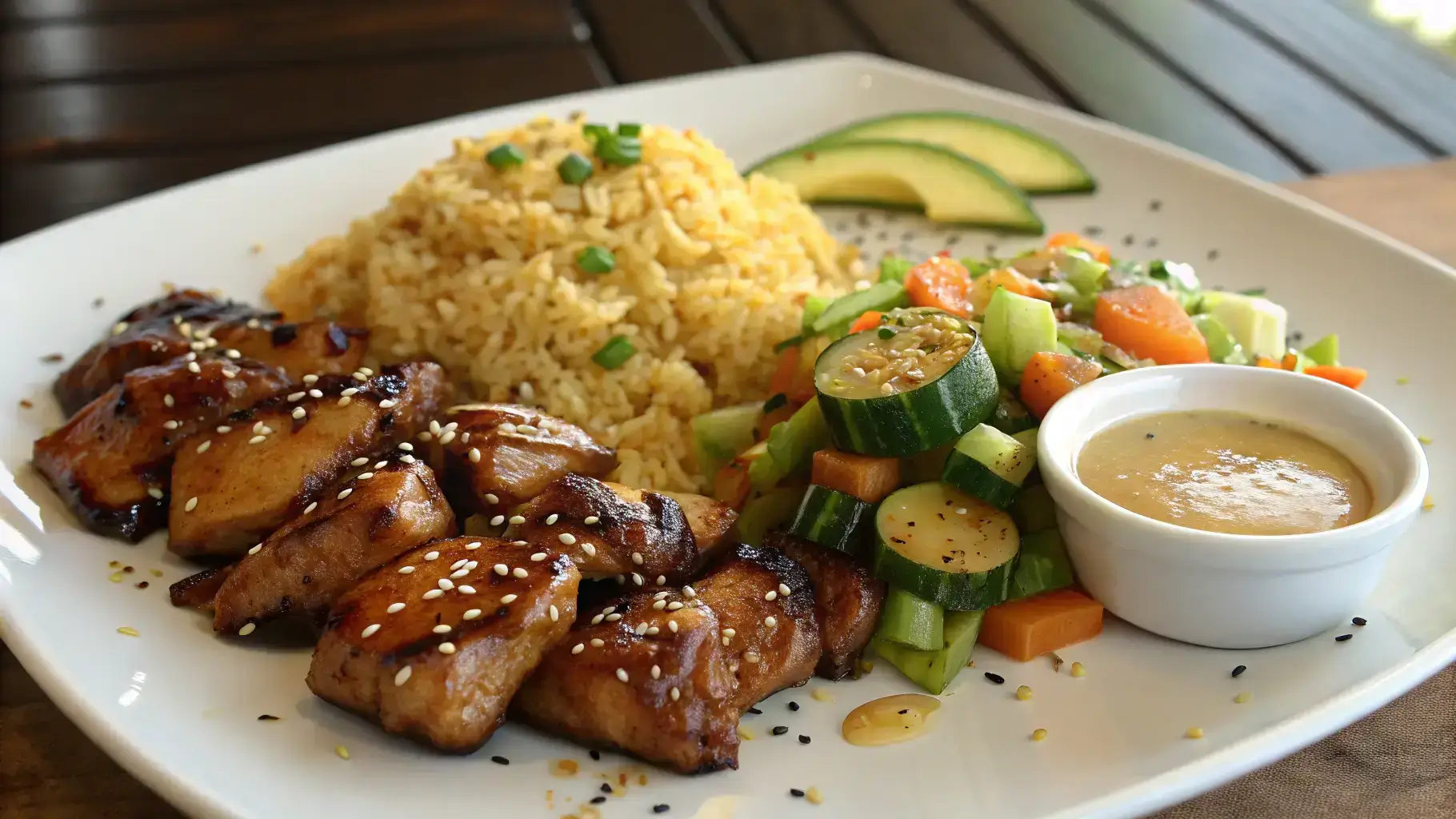Craving that Benihana flavor but not the price tag or show? This homemade hibachi chicken delivers the same sizzling flavor no griddle, no reservations, just one skillet and some pantry staples.
It’s everything you love: juicy chicken, buttery fried rice, sautéed veggies, and that must-have mustard sauce. Simple, fast, and way cheaper than eating out.
Let’s bring the hibachi home.
Table of Contents
Why This Homemade Hibachi Chicken Beats the Restaurant Version
Let’s not sugarcoat it, going out for hibachi is fun, but it’s a whole production. You wait for a table, sit through the same jokes you’ve heard three birthdays in a row, and by the time the bill lands, you’re wondering if the show was worth the price tag. Making hibachi chicken at home? It’s a game changer.
More Control, Less Chaos
At home, you decide the portions, salt level, oil, and how spicy that mustard sauce gets. Want more veggies? Easy. Prefer chicken thighs over breasts? Go for it. No one’s rushing you or flipping shrimp at your face.
Same Flavor, Lower Cost
A single Benihana meal can run $25–$40 easy. This version costs a fraction and serves more people. Plus, leftovers actually exist which, let’s face it, never happens when you’re out.
Weeknight-Friendly
No grill? No problem. This entire meal happens in a regular skillet. It’s faster than ordering takeout and surprisingly meal-prep friendly rice, veggies, and protein all in one.
FAQ — Is this really as good as Benihana?
Short answer: Pretty much.
Longer answer: If you nail the mustard sauce and don’t skimp on garlic or butter, you’re about 90% there. Add a sizzling plate and you’ll forget you’re at home
Ingredients You’ll Need (And Easy Substitutions)
No need for a specialty store run this hibachi chicken recipe sticks to ingredients you probably already have (or can easily swap). And if you’re the kind of cook who eyeballs and improvises, there’s plenty of wiggle room.
Want another bold-flavored chicken option? Try our easy orange chicken recipe.

For the Chicken
- Chicken breasts – Lean and classic. Prefer juicier? Use boneless thighs.
- Sesame oil – Adds that deep, nutty flavor. Sub with olive oil if needed.
- Soy sauce – Go low-sodium if you’re watching salt. Tamari or coconut aminos work too.
- Hoisin sauce – Sweet and savory. If you’re out, double the soy sauce and toss in a little brown sugar.
- Garlic & ginger – Fresh is ideal, but paste or jarred versions totally pass in a pinch.
For the Mustard Sauce
- Light mayo – Full-fat works just fine.
- Soy sauce – Again, tamari or coconut aminos = safe swaps.
- Rice vinegar – Apple cider vinegar or champagne vinegar can sub in.
- Dijon mustard – Want more kick? Try Japanese hot mustard. This hibachi sauce is key to elevating your homemade meal.
Or, switch things up with our creamy and spicy Bang Bang sauce instead.
For the Veggies
- Olive oil – Or any neutral oil like avocado or canola.
- Carrots, zucchini, mushrooms, onion – Use what’s in your fridge. Broccoli, bell peppers, or even snap peas play well here.
- Soy sauce, salt & pepper – Simple seasoning goes a long way.
For the Fried Rice
- Cooked white rice – Day-old is ideal. Sticky fresh rice can get clumpy.
- Butter – Adds that rich, restaurant-style flavor.
- Garlic, soy sauce – Staples you probably already have.
- Egg – Scrambled right in the middle of the pan.
- Green onions – Optional, but they brighten everything.
Want to kick up the flavor? Make it with our spicy fried rice recipe.
FAQ — What if I want to make it low-carb?
Swap the white rice for cauliflower rice or shirataki rice. Skip the hoisin, and double up on veggies it’ll still hit the spot in your healthy homemade hibachi dinner
How to Make Hibachi Chicken (Step-by-Step)
This isn’t one of those high-stakes recipes where everything has to be perfect. It’s more like controlled chaos but the good kind. You’ll be working with one pan, jumping between sauce, rice, and veggies, and at some point you’ll wonder if you’re doing it right. You are. Just breathe.

Step 1: Get that chicken marinating
Dice up the chicken and throw it in a bowl with sesame oil, soy sauce, hoisin, garlic, and ginger. Mix it around no need to massage it like a spa day. While it soaks, move on. Even 10 minutes is enough.
Step 2: Sear it hard
Heat up a big pan until it feels hot just standing over it. Toss the chicken in marinade and all. Let it sit for a sec before flipping. You want that browned edge. Once it’s cooked through (cut into a piece if you’re unsure), pull it out and set it aside. Don’t clean the pan seriously, leave that flavorful mess in there.
Step 3: Sauce time
In a small bowl, stir up mayo, soy sauce, rice vinegar, and Dijon. Taste it. Tweak it. Want it punchier? Add a splash more vinegar. Want to clear your sinuses? A dab of hot mustard’ll do it.
Step 4: Veggie moment
Same pan, splash of oil. Toss in the chopped veggies. Don’t crowd them — let them get a little color. Stir now and then, but mostly let them cook undisturbed so they caramelize instead of steam. Season with soy sauce, salt, pepper — you know the drill.
Step 5: Fried rice, the lazy genius way

Push veggies aside or take them out if your pan’s not roomy. Melt some butter, add garlic, then rice. Stir it around to coat, then make a hole in the center and crack in your egg. Scramble it right there, then mix it into the rice. Green onions go in last they’re delicate.
Step 6: Bring it all together

Spoon some rice into bowls or plates, pile on the chicken and veggies, drizzle the mustard sauce (or drown it — no judgment). That’s it. You made hibachi. And honestly? It might be better than the place with the onion volcano.
FAQ — Can I just cook everything together to save time?
You can. But do I recommend it? Not really. It’ll taste fine, just a little… muddled. Giving each part its own moment makes the flavors pop.
Don’t Skip the Mustard Sauce — Here’s Why
You could absolutely eat the chicken, rice, and veggies on their own and still walk away happy. But the mustard sauce? That’s the thing. It’s the one component that turns your homemade version from “pretty good stir-fry” into “wait, did I just recreate a restaurant dish?”
This creamy mustard sauce is practically iconic at Benihana and only takes about 15 minutes to mimic at home (Fancy Apron).
It’s nostalgic, weirdly addictive, and oddly perfect
You ever try eating hibachi at Benihana without the mustard sauce? Yeah it’s not the same. That sauce is kinda wild. It’s creamy, sharp, just a little spicy… and somehow it makes everything taste more like itself. The rice, the chicken, even the zucchini all of it hits harder with that sauce drizzled over the top. Honestly, it’s less of a condiment and more of a vibe.
DIY flavor therapy
Making it at home also gives you room to play. Want it creamier? Add more mayo. Want it sharper? Extra vinegar. Want to breathe fire? A squeeze of Japanese hot mustard or even horseradish will get you there.
What you don’t want is to skip it entirely and realize mid-meal that something’s missing. Because you will notice.
FAQ — Can I use another sauce instead?
Totally. Ginger sauce, yum yum sauce, spicy mayo they all work. But if you’re aiming for that Benihana memory lane moment? Mustard is the move in your hibachi-style dinner.
Want a lighter seafood version? Check out our garlic butter shrimp and rice.
Tips for Perfect Fried Rice & Veggie Saute
Fried rice and sautéed veggies seem simple until you end up with mushy rice or soggy zucchini. These parts of the dish are deceptively easy to mess up… but also super easy to nail once you know what to watch for.
Use day-old rice (or fake it)
Freshly cooked rice = steamy and soft, which turns to glue in the pan. If you forgot to make it ahead, spread hot rice on a baking sheet, pop it in the fridge for 30 minutes. It’s not perfect, but it helps.
Don’t crowd the pan
If your veggies are stacked on top of each other, they’ll steam — not brown. Give them room. You want those caramelized edges, not a sauna situation.
Let stuff sit
It’s tempting to stir constantly, especially with rice, but let it rest against the pan for a minute between flips. That’s how you get those golden bits that taste borderline addictive.
Use butter, not just oil
Butter gives the rice that restaurant flavor. Oil alone doesn’t quite hit the same.
Add the egg at the end
Crack it into the rice once it’s hot and scramble it fast. Don’t overthink it — it’s more about texture than technique.
FAQ — Can I use frozen veggies for this?
Absolutely. Just thaw them first and pat dry. Otherwise, you’ll end up with extra water in the pan and that soggy stir-fry energy nobody wants
FAQs About Homemade Hibachi Chicken
In Japan, hibachi originally referred to a charcoal brazier not the flat grill style cooked on today. Over time, the American misnomer stuck (Cookeryaki).
This wraps up everything you need to master a hibachi chicken with fried rice dish in your own kitchen.
What is hibachi seasoning made of?
It’s usually some mix of soy sauce, sesame oil, garlic, maybe a splash of mirin or sake. There’s no one “official” version it kind of depends on who’s cooking and what they’ve got on hand.
What makes the hibachi flavor?
Part of it is the sauce, sure, but honestly? It’s the heat. That almost smoky edge comes from searing everything fast on a hot surface. Add butter, garlic, and soy sauce boom, hibachi.
What is normally in hibachi?
You’ll usually find grilled chicken or steak, fried rice, some sautéed veggies (think zucchini, mushrooms, onions), and a dipping sauce. Simple setup, big flavor.
What do they put in hibachi rice?
Butter and soy sauce for sure. Garlic, too. They’ll usually toss in an egg right on the grill and maybe a few extras like green onions or peas depending on the place.
What do hibachi chefs squirt on rice?
Mostly oil or soy sauce sometimes both. And occasionally it’s that garlic butter mix that smells amazing. It’s part flavor boost, part keeping things from sticking.
Why is hibachi food so good?
Because it hits that salty-buttery-umami note in the best way. Plus it’s made fresh, fast, and super hot which honestly just makes everything taste better.
What oil do hibachi chefs use?
Neutral oils like canola or vegetable oil for cooking they can handle high heat. Then they layer in sesame oil or butter for flavor once things are sizzling.
What do hibachi chefs use?
Besides some serious spatula skills? A flat grill, soy sauce, garlic butter, sesame oil and a whole lot of heat. Timing matters more than fancy tools.
Why do Americans call it hibachi?
Technically, hibachi’s a small Japanese charcoal grill. What we call hibachi here is actually teppanyaki. But the name stuck, and honestly, most folks just roll with it.

Hibachi Chicken {Benihana Copycat}
Ingredients
Equipment
Method
- Mix together hibachi chicken ingredients and pour over diced chicken. Cook in a skillet over medium-high heat for 10 minutes until fully cooked. Set aside.
- In a bowl, whisk together the mustard sauce ingredients. Set aside.
- In the same skillet, sauté vegetables with olive oil and soy sauce for about 5 minutes until tender-crisp. Set aside.
- Melt butter in the skillet. Sauté garlic for 30 seconds, add cooked rice and soy sauce, and stir-fry for 5 minutes. Push rice to one side and scramble the egg in the middle. Mix everything and stir in green onions.
- Plate the chicken, veggies, and fried rice. Drizzle with mustard sauce or serve on the side. Enjoy your homemade hibachi dinner!
Notes
From Hibachi to Home: Final Thoughts
There’s something deeply satisfying about taking a dish that usually requires a chef with flying spatulas and recreating it minus the theatrics in your own kitchen. Hibachi chicken, it turns out, doesn’t need a griddle, a show, or even a special occasion. It just needs you, a hot skillet, and a little sauce on the side.
Maybe you made it for the nostalgia. Maybe it’s just because takeout was too expensive this week. Either way, you pulled off a full hibachi spread rice, veggies, chicken, the whole deal without ever leaving home. And that’s worth celebrating.
So the next time someone suggests Benihana? Smile. Then casually say, “We could just make it here.”

